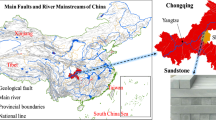Abstract
The equivalent permeability tensor is essential to the application of the equivalent porous media model in the numerical seepage simulation for fractured rock masses. In this paper, a revised solution of the equivalent permeability tensor is proposed to represent the influence of the fracture connectivity in discontinuous fractures. A correction coefficient is involved to reflect the com- plex seepage flow type through the rock bridge. This correction coefficient is back analyzed from single-hole packer tests, based on the Artificial Neural Network (ANN) back analysis and the Finite Element Method (FEM) seepage simulation. The limitation of this back analysis algorithm is that the number of single-hole packer tests should be equal or greater than the number of fracture sets, and three is the maximum number of the fracture sets. The proposed solution and the back analysis algorithm are applied in the permeability measurement and the seepage simulation for the Xiaowan arch dam foundation.
Similar content being viewed by others
References
ODA M. Permeability tensor for discontinuous rock masses [J]. Geotechnique, 1985, 35(4): 483–495.
BRIAN B., OLIVIER B. and PHILIPPE D. et al. Scaling of fracture connectivity in geological formations [J]. Geophysical Research Letters, 2000, 27(14): 2061–2064.
ZKAYA S. I., MATTNER J. Fracture connectivity from fracture intersections in borehole image logs [J]. Computers and Geosciences, 2003, 29(2): 143–153.
WANG M., KULATILAKE P. H. S. W. and UM J. et al. Estimation of REV size and three-dimensional hydraulic conductivity tensor for a fractured rock mass through a single well packer test and discrete fracture fluid flow modeling [J]. International Journal of Rock Mecha-nics and Mining Sciences, 2002, 39(7): 887–904.
MIN K. B., JING L. and STEPHANSSON O. Determining the equivalent permeability tensor for fractured rock masses using a stochastic REV approach: Method and application to the field data from Sellafield, UK [J]. Hydrogeology Journal, 2004, 12(5): 497–510.
MIN K. B., RUTQVIST J. and TSANG C. F. et al. Stress-dependent permeability of fractured rock masses: A numerical study [J]. International Journal of Rock Mechanics and Mining Sciences, 2004, 41(7): 1191–1210.
CAI Jin-long, ZHOU Zhi-fang and HUANG Yong. Laboratory experiments on solute transport in a partial transfixion single fracture [J]. Journal of Hydrodynamics, 2011, 23(5): 570–579.
MOON J. S. Representativeness of jointed rock mass hydraulic conductivity obtained from packer tests for tunnel inflow rate estimate [J]. International Journal of Rock Mechanics and Mining Sciences, 2011, 48(5): 836–844.
ANGULO B., MORALES T. and URIARTE J. A. et al. Hydraulic conductivity characterization of a karst re-charge area using water injection tests and electrical re-sistivity logging [J]. Engineering Geology, 2011, 117(1-2): 90–96.
HE J., CHEN S. H. and SHAHROUR I. Back analysis of equivalent permeability tensor for fractured rock masses from packer tests [J]. Rock Mechanics and Rock Engineering, 2011, 44(4): 491–496.
SAUSSE J., DEZAYES C. and GENTER A. et al. Characterization of fracture connectivity and fluid flow pathways derived from geological interpretation and 3D modeling of the deep seated EGS reservoir of Soultz (France) [C]. The 33th Workshop on Geothermal Reservoir Engineering. Stanford, California, USA: Stanford University, 2008, SGP-TR-185.
SONMEZ H., GOKCEOGLU C. and NEFESLIOGLU H. A. et al. Estimation of rock modulus: For intact rocks with an artificial neural network and for rock masses with a new empirical equation [J]. International Journal of Rock Mechanics and Mining Sciences, 2006, 43(2): 224–235.
HOSEIN R., AHMAD J. Artificial neural networks as a basis for new generation of rock failure criteri [J]. International Journal of Rock Mechanics and Mining Sciences, 2011, 48(7): 1153–1159.
LOUIS C., MAINI Y. N. Determination of in situ hydraulic parameters in jointed rock [C]. The 2nd Congress of International Society for Rock Mechanics. Belgrade, Yugoslavia, 1970, 235–245.
HSIEH P. A., NEUMAN S. P. Field determination of the three dimensional hydraulic conductivity tensor of anisotropic media 1, Theory [J]. Water Resources Research, 1985, 21(11): 1655–1665.
HSIEH P. A., NEUMAN S. P. and STILES G. K. et al. Field determination of the three-dimensional hydraulic conductivity tensor of anisotropic media 2, Methodology and application to fractured rocks [J]. Water Resources Research, 1985, 21(11): 1667–1676.
CHEN Y. F., ZHOU C. B. and ZHENG H. A numerical solution to seepage problems with complex drainage systems [J]. Computers and Geotechnics, 2008, 35(3): 383–393.
ZHANG You-tian, CHEN Ping and WANG Lei. Initial flow method for seepage analysis with free surface [J]. Journal of Hydraulic Engineering, 1988, (8): 18–26(in Chinese).
FANG K. T., LIN D. K. J. and WINKER P. et al. Uni-form design: Theory and application [J]. Technometrics, 2000, 42(3): 237–248.
Author information
Authors and Affiliations
Corresponding author
Additional information
Project supported by the National Natural Science Foundation of China (Grant No. 51079109).
Biography: HE Ji (1982-), Male, Ph. D.
Rights and permissions
About this article
Cite this article
He, J., Chen, SH. & Shahrour, I. A Revised Solution of Equivalent Permeability Tensor for Discontinuous Fractures. J Hydrodyn 24, 711–717 (2012). https://doi.org/10.1016/S1001-6058(11)60295-3
Received:
Revised:
Issue Date:
DOI: https://doi.org/10.1016/S1001-6058(11)60295-3




